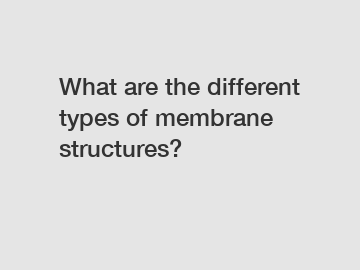What are the different types of membrane structures?
What are the different types of membrane structures?
Membrane structures are gaining popularity in the construction industry due to their lightweight, flexibility, and aesthetic appeal. These structures are made of a flexible membrane that is stretched over a frame to create a roofing or shading system. From providing shade in outdoor spaces to covering large stadiums, membrane structures offer a versatile and cost-effective solution. Let's take a closer look at the different types of membrane structures commonly used in architecture and construction.
1. Tensile Membrane Structures.

Tensile membrane structures are the most common type of membrane structures. They consist of a fabric membrane that is tensioned and supported by a structural framework. The fabric membrane can be made of materials such as PVC, PTFE, or ETFE, which provide durability, flexibility, and resistance to environmental factors. These structures can be freestanding or attached to a building, and they can be used to cover large areas while allowing natural light to filter through.
2. Pneumatic Membrane Structures.
Pneumatic membrane structures are formed by inflating a fabric membrane to create a tensile structure. Air pressure is used to maintain the shape and stability of the structure. These structures are lightweight, portable, and can be easily set up and taken down. Pneumatic membrane structures are often used for temporary shelters, event spaces, and emergency relief structures.
3. Cable and Mast Supported Structures.
Cable and mast supported structures are created by tensioning fabric membranes between cables or masts. The cables or masts provide the necessary support and stability for the structure. These structures are popular for their clean, minimalist design and can be used for shading systems, canopies, and facades. The fabric membranes used in cable and mast supported structures can be translucent or opaque, offering a range of light transmission options.
4. ETFE Cushion Systems.
ETFE (Ethylene Tetrafluoroethylene) cushion systems are composed of multiple layers of ETFE film inflated by air or gas. These systems provide excellent thermal insulation while allowing a high level of natural light transmission. ETFE cushion systems are commonly used for roofing and façade applications in stadiums, airports, and exhibition centers. They are known for their energy efficiency, lightweight, and ability to withstand extreme weather conditions.
In conclusion, membrane structures offer an innovative and versatile solution in the field of architecture and construction. From tensile membrane structures to pneumatic structures, each type offers its own unique advantages and applications. Whether you need a shading system for an outdoor space or a large-scale roofing solution, there is a membrane structure suitable for your needs.
If you are interested in exploring the possibilities of membrane structures for your next project, please do not hesitate to contact us. Our team of experts will be happy to assist you in designing and implementing the perfect membrane structure for your specific requirements.
The company is the world’s best glass curtain wall wholesalers, custom space steel structures, Framing Membrane Structure supplier. We are your one-stop shop for all needs. Our staff are highly-specialized and will help you find the product you need.

Comments